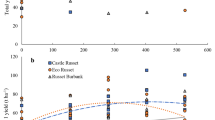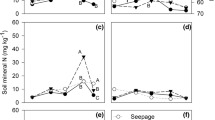Abstract
Potassium and N fertilization is often required for maximum potato (Solanum tuberosum L.) production. Nitrogen, K, and K-sources (KCl, K2SO4 are known to affect yield and quality of potatoes but N and K interactions as affected by K-source have not been defined. This study evaluated the N*K and K-source interactions on Russet Burbank tuber yields and specific gravity (SG) in two irrigated field experiments. Nitrogen rates of 0, 112, 224 or 336 kg ha-1 were combined with selected K rates of 0,112, 224 or 448 kg ha-1 as either KC1 or K2SO4 in an incomplete factorial. A multiple linear regression model was fit to the data and used to predict yield and SG for a complete factorial for each K-source. Both N and K applications increased yields independent of K-source. Nitrogen decreased yields at the 336 kg ha-1 rate. Potassium increased yields up to 448 kg K ha-1. Both K-sources decreased SG a similar amount with N application; without N, KC1 decreased SG but K2SO4 did not. Nitrogen also decreased SG. Petiole NO3-N and K concentrations were positively related to yields and negatively to specific gravities. The petiole K concentration 100 days after planting should be above 4.5 for highest tuber yields. The N*K*K-source interaction was important for yields at low available N and for SG at adequate N availabilities. This study showed that N or K fertilizers can be applied according to their respective soil test concentration and the crop’s requirement, generally without consideration of K-source.
Compendio
Para una producción máxima de papa (Solarium tuberosum L.) se requiere frecuentemente de la fertilización nitrogenada y potásica. Se sabe que el nitrógeno (N), el potasio (K) y las fuentes de potasio (KCL, K2SO4) afectan el rendimiento y la calidad de la papa, pero las interacciones del N y el K en relation a la fuente de K no han sido definidas. Este estudio evaluó en dos experimentas de campo bajo irrigación las interacciones de N*K con la fuente de K sobre los rendimientos en tubérculos y la gravedad específica (GE) de Russet Burbank. Dosis de nitrógeno de 0,112, 224 o 336 kg ha-1 se combinaron con dosis seleccionadas de Kde 0,112, 224 o 448 kg ha-1 como KCL o como K2S4 en un factorial incompleto. Un modelo de regresión lineal multiple fue adaptado a los datos y utilizado para pronosticar el rendimiento y la GE por un factorial complete para cada fuente de K. Tanto las aplicaciones de N como las de K incrementaron los rendimientos independientemente de la fuente de K. La dosis de 336 kg ha-1 de nitrógeno disminuyó los rendimientos. El potasio, hasta 448 kg ha-1, aumentó los rendimientos. Ambas fuentes de K disminuyeron la GE en cantidades similares con la aplicación de N; sin N, el KCL disminuyó la GE, lo que no hizo el K2PO4. El N también disminuyó la GE. Las concentraciones de NO3-N y de K en el peciolo estuvieron positivamente relacionadas a los rendimientos, y negativamente a las gravedads específicas. Las concentraciones de potasio en el peciolo, 100 días después de la siembra, debieron ser superiores a 4.5 para los más altos rendimientos en tubérculos. La interacción N* K* fuente de K fue importante para rendimientos a bajo contenido disponible de N y para GE a disponibilidades de N adecuadas. Este estudio muestra que los fertilizantes nitrogenados y potásicos pueden ser aplicados de acuerdo a su concentración en el suelo y los requerimientos del cultivo, sin considerar, generalmente, la fuente de potasio.
Similar content being viewed by others
Literature Cited
Brautlecht, C.A. and A.S. Getchell. 1951. The chemical composition of white potatoes. Am Potato J 28:531–550.
Cate, R.B. and L.A. Nelson. 1971. A simple statistical procedure for partitioning soil test correlation data into two classes. Soil Sci Soc Am Proc 35:658–660.
Dibb, D.W. and W.R. Thompson, Jr. 1985. Interactions of potassium with other nutrients. Pages 515–533.In: Potassium in Agriculture. R.D. Munson, Ed. ASA, Madison, WI.
Dubetz, S. and J.B. Bole. 1975. Effect of nitrogen, phosphorus and potassium fertilizers on yield components and specific gravity of potatoes. Am Potato J 52:399–405.
Harris, P.M. 1978. The potato crop — The scientific basis for improvement. Chapman and Hall, London.
Harrison, H.C., E.L. Bergman and R.H. Cole. 1982. Growth responses, cooking quality determinations, and leaf nutrient concentrations of potatoes as related to exchange able calcium, magnesium, and potassium in the soil. Am Potato J 59:113–124.
James, D.W., R.L. Hurst, D.T. Westermann and T.A. Tindall. 1994. Nitrogen and potassium fertilization of potato: Evaluating nutrient element interactions in petioles with response surfaces. (Accepted by Am Potato J, Nov. 1993)
James, D.W. and J.J. Jurinak. 1986. Irrigation resources in Utah: Water quality versus soil salinity, soil fertility and the environment. Utah Agric Exp Sta Research Bull 514.
James, D.W., M.H. Weaver and R.L. Reeder. 1968. Soil test index of plant available potassium and the effects of cropping and fertilization in Central Washington irrigated soils. Washington State University Bull 697.
James, D.W., W.H. Weaver and R.L. Reeder. 1970. Chloride uptake by potatoes and the effect of potassium chloride, nitrogen and phosphorus fertilization. Soil Sci 109:48–52.
Kitson, R.E. and M.G. Mellon. 1944. Colorimetric determination of phosphorus as molydivanado phosphoric acid. Ind Eng Chem Anal Ed 16:379–383.
Kittams, H.A. and W.P. Mortenson. 1956. The effect of nitrogen and potash on yield and specific gravity of potatoes. Proc 7th Annual Fert Conf, Northwest Plant Food Assoc. pp. 1–4. Yakima, WA.
Kleinkopf, G.E. and D.T. Westermann. 1987. Scheduling nitrogen applications for Russet Burbank potatoes. University of Idaho CIS No 637.
Kunkel, R. and I.A. Dow. 1961. Effect of nitrogen, phosphorus, and potash on yield and quality of Russet Burbank potatoes in the Columbia Basin of Washington. Proc 12th Annual Fert Conf, Northwest Plant Food Assoc. pp. 37–50. Salem, OR.
Kunkel, R. and R. Thornton. 1971. Growth of the potato. Proc 10th Annual Wash State Potato Conf Trade Fair. pp. 111–123. Moses Lake, WA.
McDole, R.E., G.F. Stallknecht, R.B. Dwelle and J.J. Pavek. 1978. Response of four potato varieties to potassium fertilization in a seed growing area of Eastern Idaho. Am Potato J 55:495–504.
McDole, R.E., D.T. Westermann, G.D. Kleinschmidt, G.E. Kleinkopf and J.C. Ojala. 1991. Potatoes. University of Idaho CIS No 261.
Milham, P.J., A.S. Awad, R.E. Pauli and J.H. Bull. 1970. Analysis of plant, soils, and water for nitrate using an ion-selective electrode. Analyst 95:751–757.
Murarka, I.P., T.L. Jackson and D.P. Moore. 1973. Effects of N, K, and Cl on nitrogen components of Russet Burbank potato plants (Solanum tuberosum L.). Agron J 65:868–870.
Neter, J., W. Wasserman and M.H. Kutner. 1989. Applied linear regression models. Rich ard D. Irwin, Inc., Homewood, Ill. 60430. 667 p.
Prummel, J. and Pa Von Barnau-Sijthoff. 1984. Optimum phosphate and potassium levels in potato tops. Fertilizer Research 5:203–211.
Rhue, R.D., D.R. Hensel and G. Kidder. 1986. Effect of K fertilization on yield and leaf nutrient concentrations of potatoes grown on a sandy soil. Am Potato J 63:665–681.
Rowberry, R.G. and J.W. Ketcheson. 1978. Sources of potassium in potato fertilizer and times of application. Can J Plant Sci 58:779–782.
Sharma, U.C. and B.R. Arora. 1989. Critical nutrient ranges for potassium in potato leaves and petioles. J Hort Sci 64:47–51.
Westermann, D.T., D.W. James, TA, Tindall and R.L. Hurst. 1994. Nitrogen and potas sium fertilization of potatoes: sugars and starch. (Accepted by Am Potato J, Jan. 1994)
Westermann, D.T. and G.E. Kleinkopf. 1980. Russet potato growth and nitrogen require ments. Proc 31st Annual Fert Conf, NWPFA. pp. 87–100. Salt Lake City, UT.
Westermann, D.T. and G.E. Kleinkopf. 1981. Predicting N fertilizer applications for pota toes. Proc 32nd Annual Fert Conf, NWPFA. pp. 51–57. Billings, MT.
Western Fertilizer Handbook. 1990. Soil Improvement Committee of California. Chapter 9 Soil and Tissue Testing. pp. 149–167. The Interstate Printers and Publishers, Inc., Danville, IL.
Author information
Authors and Affiliations
Additional information
Contribution from USDA-ARS and the Utah Agric. Expt. Station, Logan, UT.
Professor Emeritus
Rights and permissions
About this article
Cite this article
Westermann, D.T., Tindall, T.A., James, D.W. et al. Nitrogen and potassium fertilization of potatoes: Yield and specific gravity. American Potato Journal 71, 417–431 (1994). https://doi.org/10.1007/BF02849097
Accepted:
Issue Date:
DOI: https://doi.org/10.1007/BF02849097




